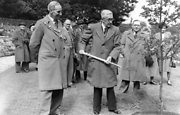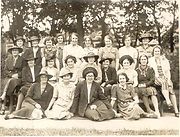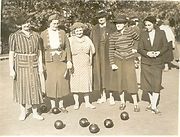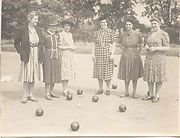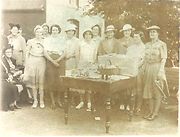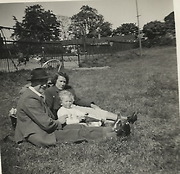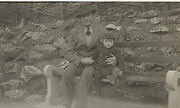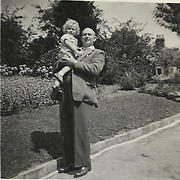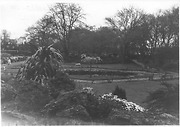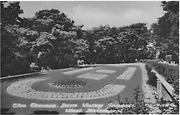 Hartlepool Sports & Leisure
Hartlepool Sports & Leisure
- Cinemas, Theatres & Dance Halls
- Musicians & Bands
- At the Seaside
- Parks & Gardens
- Caravans & Camping
- Sport
 Hartlepool Transport
Hartlepool Transport
- Airfields & Aircraft
- Railways
- Buses & Commercial Vehicles
- Cars & Motorbikes
- The Ferry
- Horse drawn vehicles
 A Potted History Of Hartlepool
A Potted History Of Hartlepool
- Unidentified images
- Sources of information
- Archaeology & Ancient History
- Local Government
- Printed Notices & Papers
- Aerial Photographs
- Events, Visitors & VIPs
 Hartlepool Trade & Industry
Hartlepool Trade & Industry
- Trade Fairs
- Local businesses
- Iron & Steel
- Shops & Shopping
- Fishing industry
- Farming & Rural Landscape
- Pubs, Clubs & Hotels
 Hartlepool Health & Education
Hartlepool Health & Education
- Schools & Colleges
- Hospitals & Workhouses
- Public Health & Utilities
- Ambulance Service
- Police Services
- Fire Services
 Hartlepool People
Hartlepool People
 Hartlepool Places
Hartlepool Places
 Hartlepool at War
Hartlepool at War
 Hartlepool Ships & Shipping
Hartlepool Ships & Shipping

Details about Burn Valley Gardens
The Burn Valley Gardens, Hartlepool was opened to the public in 1898. Bowling greens were added in 1913.
Location
Related items () :
 A Walk in the Park
A Walk in the Park
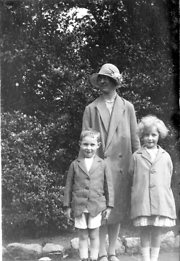 Donated by Mrs. Maureen Ledington
Donated by Mrs. Maureen LedingtonDated 1928
Mary Scurr with Billy and Olive taking a stroll around the Burn Valley Gardens, in 1928.
More detail » A big change 1960s to 2016 (1)
A big change 1960s to 2016 (1)
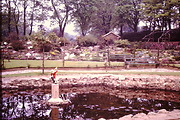 Created by Doris Wilson
Donated by the family of the late Doris Wilson
Created by Doris Wilson
Donated by the family of the late Doris WilsonThis beautiful view taken in the mid 1960s shows the greatly missed Peter Pan pond and statue, the manicured grass ,tended rockeries and neat wooden benches. The rockery in the background to the left of the shelter (which was a sun trap) was also a set of 'fairy steps' much loved by children. There was another set of fairy steps behind the pond and where the photographer would be standing.
Compare this to photo (2) today.
More detail » A big change 1960s to 2016 (2)
A big change 1960s to 2016 (2)
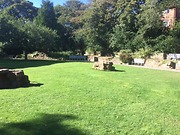 Created by F. Wilson
Donated by F.Wilson
Created by F. Wilson
Donated by F.WilsonDated 2016
This image taken in September 2016 is from the same spot as (1) The pond has been filled in, tarmac has replaced the crazy paving and the fairy steps are virtually gone. The more rustic benches have been replaced by low maintenance, vandal proof metal structures.
The rocks in the foreground are man made and part of an adventure playground. The fairy steps behind the photographer are no more and are steps to a tubular slide. The view is a fairly attractive open space and the trees are beautiful, but a very different view to (1) taken in the 1960's.
More detail » A big change 1960s to 2016 (3)
A big change 1960s to 2016 (3)
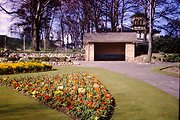 Created by Doris Wilson
Donated by family of late Doris Wilson
Created by Doris Wilson
Donated by family of late Doris WilsonTaken in the mid to late 1960s, the image is of the flower beds and shelter. The shelter is no longer there and in place of the flower beds today is a large grassed area which was seeded when the beck was diverted about 2010. To the right of the photo would be the fairy steps described in (1). The tower in the background is Claremont which was at that time either a school still or the Teachers' Centre. Part of Rosebank is also just visible.
More detail » A big change 1960s to 2016 (4)
A big change 1960s to 2016 (4)
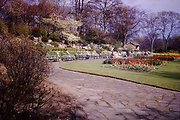 Created by Doris Wilson
Donated by the family of the late Doris Wilson
Created by Doris Wilson
Donated by the family of the late Doris WilsonThis view taken in the mid 1960s is barely recognisable now. (see 5) Here we see beautifully tended gardens, a rockery with two tiers of seating and attractive crazy paving.
More detail » A big change 1960s to 2016 (5)
A big change 1960s to 2016 (5)
 Created by F. Wilson
Donated by F. Wilson
Created by F. Wilson
Donated by F. WilsonCompare this view today with (4). we are looking in the same direction towards the rockery but one tier has gone and the seats replaced by metal benches.
At some point around 2010, the beck was diverted into a loop to prevent flooding and this loop came across part of what had been the flower bed in image 4. A grass bank now covers the rest of the flower bed area.
More detail » A big change 1960s to 2016 (6)
A big change 1960s to 2016 (6)
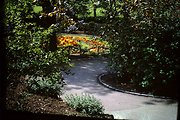 Created by Doris Wilson
Donated by the family of the late Doris Wilson
Created by Doris Wilson
Donated by the family of the late Doris WilsonThis was taken in the mid 1960s looking down into the Burn Valley from the winding path at the top of Elwick Road. Where the flower bed and rustic fencing was, there is now just an expanse of grass although the Council did plant wild flowers there in 2015.
More detail » A big change 1960s to 2016 (7)
A big change 1960s to 2016 (7)
 Created by F. Wilson
Donated by F. Wilson
Created by F. Wilson
Donated by F. WilsonDated 2016
Looking at the scene in picture 6 today is barren compared to the 1960s,70s and 80s. The flower bed, rustic fences and wooden benches are no more.
More detail » A big change 1960s to 2016 (8)
A big change 1960s to 2016 (8)
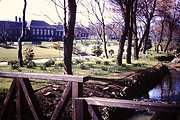 Created by Doris Wilson
Donated by the family of the late Doris Wilson
Created by Doris Wilson
Donated by the family of the late Doris WilsonThis spring view taken in the 1960s from the bridge over the burn from near Eldon Grove shows the steps up to the bowling greens and in the background is the Brinkburn Boys' Grammar School, now the 6th form College.
Today the bridge is metal, the school exterior has been remodelled and the bowling greens have a high fence around them.
Many students both then and now have crossed the Burn Valley on their way to school.
More detail » Bandstand Burn Valley Gardens (2)
Bandstand Burn Valley Gardens (2)
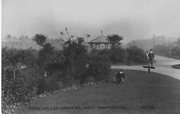 Donated by Robert Wood Collection
Donated by Robert Wood CollectionPart of the Hartlepool Museum Service collection
A bit of artistic licence has possibly been taken with the houses in the background, those on the left being Colwyn Road and on the right Stockton Street. Strathmore House is visible.
In later years, there were tennis courts in this area of the Burn Valley and then a formal rose garden.
hht&n 1045
More detail » Bandstand in Burn Valley Gardens
Bandstand in Burn Valley Gardens
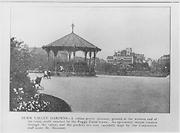 Donated by Hartlepool Library Service
Donated by Hartlepool Library ServiceDated 1912
Bandstand Burn Valley Gardens, Hartlepool taken in 1912 Strathmore House (the original private house long before its use as the co-op funeral parlour) can be seen in the background.
More detail » Beck in flood
Beck in flood
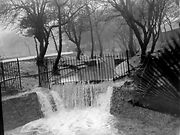 Created by NDM
Donated by Hartlepool Museum Service
Created by NDM
Donated by Hartlepool Museum ServiceDated 1954
Taken at the York Road end of the Burn Valley where the burn disappears undergroud to go under York Road, under Stockton St and Burn Road before coming out at the sea near Newburn bridge which was named because of this.
On the right would be Colwyn Road and to the left of the image were tennis courts at that time.
More detail » Bridge at top of Burn Valley
Bridge at top of Burn Valley
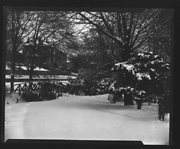 Donated by Ann Lacey
Donated by Ann LaceyPart of the Hartlepool Museum Service collection
An image taken in wintertime some years ago. This is the last bridge across the beck at the west end of the Burn Valley and Ambleside Manor can be seen on the photo.
More detail » Bridge in Burn Valley
Bridge in Burn Valley
 Donated by Ann Lacey
Donated by Ann LaceyPart of the Hartlepool Museum Service collection
A rustic bridge in the Burn Valley in wintertime . It is many years since the bridges were in this style although the date is unknown.
More detail » Bridge over beck in Burn Valley Gardens
Bridge over beck in Burn Valley Gardens
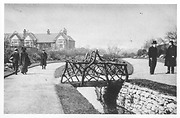 Donated by Hartlepool Library Service
Donated by Hartlepool Library ServiceBridge over beck in Burn Valley Gardens, Hartlepool. The Victoria Homes are on the left.
hht&n 1041
More detail » Burn Valley
Burn Valley
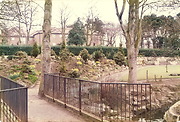 Created by Bill Henderson
Created by Bill Henderson
Taken in the mid 1980s, the view is little changed although the park is now no longer as cultivated as it was. The building in the background is of interest as it is Claremont Flats for the elderly which were built on the site of Claremont, a Victorian villa. Claremont became a school for children with special needs and then Hartlepool Teachers' Centre before being demolished in the mid 1970s. The flats in turn were demolished in the first decade of this century.
More detail » Burn Valley 1923
Burn Valley 1923
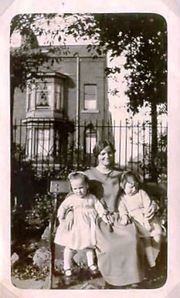 Donated by Gillian Smith
Donated by Gillian SmithDated 1923
The image shows aunt Rachel Willoughby, who emigrated to Australia not long after the photo was taken, and the children are Christianna Wright and Nellie Willoughby. The houses behind them are in Colwyn Road on the corner of Bangor St.
More detail » Burn Valley Belmont Gardens entrance
Burn Valley Belmont Gardens entrance
 Part of the Hartlepool Museum Service collection
Part of the Hartlepool Museum Service collectionThe image is taken from near the beck looking up towards Elwick Road and Belmont Gardens. Elwick Road school, which looks very new having opened in 1906, can clearly be seen.
More detail » Burn Valley Bowls Club
Burn Valley Bowls Club
 Donated by Mr. Keith Bloomfield
Donated by Mr. Keith BloomfieldDated 1941
Members of the Burn Valley Bowls Club in 1941, enjoying a game while still wearing their party hats.
More detail » Burn Valley Gardens
Burn Valley Gardens
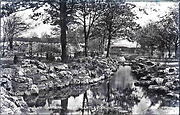 Donated by Hartlepool Library Service
Donated by Hartlepool Library ServiceBurn Valley Gardens. A picture showing the beck in the gardens.
More detail » Burn Valley Gardens
Burn Valley Gardens
 Donated by Hartlepool Library Service
Donated by Hartlepool Library ServiceBurn Valley Gardens. Two men relaxing on one of the seats in the gardens. The house in the background is Claremont, which in 1933 became a school for children with additional needs and in the early 1970s a Teachers' Centre. It was then demolished and sheltered housing built on the site. This in turn was demolished and retirement bungalows are now on the site.
More detail » Burn Valley Gardens Bandstand 1903
Burn Valley Gardens Bandstand 1903
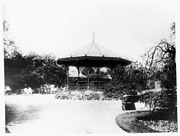 Donated by Douglas Ferriday
Donated by Douglas FerridayPart of the Hartlepool Library Service collection
Burn Valley Gardens Bandstand 1903 with members of the public around.
More detail » Burn Valley Ladies Bowls Club - 1941
Burn Valley Ladies Bowls Club - 1941
Images of the Ladies of the Burn Valley Ladies Bowls Club in 1941.
More detail » Burn Valley Playground 1950s
Burn Valley Playground 1950s
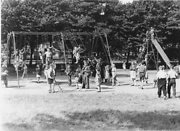 Created by northern daily mail
Donated by Hartlepool Museum Service
Created by northern daily mail
Donated by Hartlepool Museum ServiceWonderful image taken by the Hartlepool Mail in the 1950s when the playground really was as busy as the photo shows and health and safety was years away ! Notice too that there are almost no watching adults as children at the time usually went to the playground unaccompanied.
The slide really was as high as that and had a long flat part, as when it was shiny you could fly down ! On the left were the 'American swings' which needed two people, but often had up to eight, and were moved by pushing the feet on bars which hung below the swing.
Out of sight on the picture was a 'teapot lid' roundabout, a large rocking horse and a 'witch's hat'.
In the background, the lower Burn Valley Bowls Club can be seen and just visible behind that are the Victoria Homes.
More detail » Burn Valley late 1940s
Burn Valley late 1940s
 Donated by Christine Moore
Donated by Christine MooreDated 1946
The photo shows Lily Jenkins in the Burn Valley beside the 'Peter Pan pond' . This was filled in some years ago and an adventure playground has been built where it was. The statue of Peter Pan was often stolen and replaced. In the background is Claremont, a Victorian villa which,after being a private home, was first a special school for children with learning needs and before being demolished was Hartlepool Teachers' Centre. Sheltered housing was then built on the site but this is now demolished and recently a retirement development is in its place.
More detail » Burn Valley looking east
Burn Valley looking east
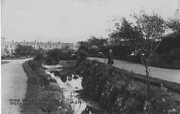 Part of the Hartlepool Museum Service collection
Part of the Hartlepool Museum Service collectionThe aspect is not quite clear although it is looking east and the houses on the left are in Colwyn Road. It is possibly close to Bangor and Powell Streets where there is a short entrance much like the path off on the left. It could be streets east of Baden Street.
The detail on the houses looks to have possibly been sketched in making the exact location difficult.
More detail » Burn Valley near Bangor Street
Burn Valley near Bangor Street
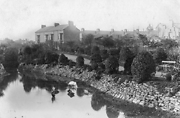 Part of the Hartlepool Museum Service collection
Part of the Hartlepool Museum Service collectionA fascinating photo which shows the Burn Valley beck(looking more rustic and cleaner than it does now) and houses behind. It has probably been taken from the Baden Street/ allotments area. The terrace of houses are those between Burn Valley Road and Bangor Street in Colwyn Road and at right angles to them is Burn Valley Road. The houses are still there and another must have been added to the terrace possibly as Bangor Street was built.The scaffolding for the building work for this street appears on the photo.
In the background, Elwick Road School can be clearly seen and this was opened in 1906.To the right of the terrace of houses on the other side of Bangor Street is now a further terrace of houses with a stone dating them as 1911. The photo was taken therefore between 1906 and 1911.
Because of large mature trees, it is quite difficult to see the view from this point today.
More detail »
 Burn Valley playground
Burn Valley playground
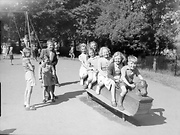 Created by NDM
Donated by Hartlepool Museum Service
Created by NDM
Donated by Hartlepool Museum ServiceThe playground in the lower part of the Burn Valley was very popular in the 1950s and 60s in particular when there was never an adult in sight ! Here the children are on the rocking horse.
More detail » Burn Valley stroll
Burn Valley stroll
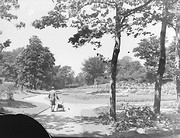 Created by NDM
Donated by Hartlepool Museum Service
Created by NDM
Donated by Hartlepool Museum ServiceThis idyllic, peaceful scene of the early 1950s would be impossible to find today. The 'fairy steps' would be just to the right, and the whole area where the man is pushing the pram is now the grassland where the beck has been diverted.
Sadly, the flower beds to the right are a thing of the past too.
More detail » Dog-tired
Dog-tired
 Donated by Mrs. Maureen Ledington
Donated by Mrs. Maureen LedingtonDated 1928
Jeannie Lappin and her dog taking a breather on a walk around the Burn Valley Gardens in 1928.
More detail » Fun in the snow
Fun in the snow
 Created by NDM and Don Stephenson
Donated by Hartlepool Museum Service
Created by NDM and Don Stephenson
Donated by Hartlepool Museum ServiceDated 1964
For many, many years children used the slopes in the Burn Valley for sledging on snowy winter days. With a good sledge and hard packed snow, it was possible to fly across the bridge over the beck or perhaps in it! This image was taken in December 1964. Notice that there are no visible adults !
By contrast, see the right hand image Taken from the same spot now. Around 2010, the council altered the land at bottom of the hill and made it a 'wild' area where children could hopefully pond dip and watch wildlife. Unfortunately this idea does not seem to have worked very well and today's generation of children will never be able to have fun in the snow like their parents and grandparents did.
More detail » In the Burn Valley Gardens
In the Burn Valley Gardens
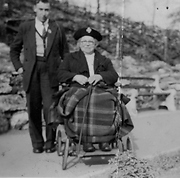 Donated by Mr. Alan Archbold
Donated by Mr. Alan ArchboldDated 1954
Alan Archbold's Grandma Mary and cousin Colin Archbold, in the Burn Valley Gardens in 1954.
More detail » In the Gardens
In the Gardens
Images of the Henderson family enjoying a day in the Burn Valley Gardens.
More detail » Party time at the Bowls Club
Party time at the Bowls Club
 Donated by Mr. Keith Bloomfield
Donated by Mr. Keith BloomfieldDated 1941
1941. Members of the Burn Valley Bowls Club gather round one of the greens sporting a fine array of hats - fancy-dress party perhaps?
More detail » Peter Pan 2017
Peter Pan 2017
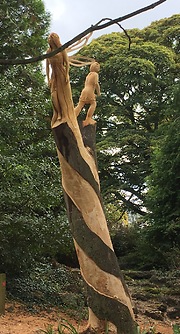 Created by F.Wilson
Dated 2017
Created by F.Wilson
Dated 2017In September 2017, a tree sculpture was unveiled in the Burn Valley. It was executed by Tom Craggs from Consett and depicts Peter Pan and Tinkerbell. The sculpture reflects the long gone Peter Pan pond and statue and the 'fairy steps' which were nearby.
The project was funded by Tesco Bags of Help Scheme, the money raised by carrier bag sales.
More detail » Peter Pan Pond
Peter Pan Pond
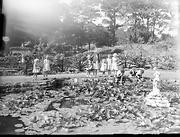 Created by NDM
Donated by Hartlepool Museum Service
Created by NDM
Donated by Hartlepool Museum ServiceTaken in the early 1950s, a group of children are probably looking for fish amongst the lilies in the Peter Pan pond in the Burn Valley.
More detail » Schoolboys in Burn Valley
Schoolboys in Burn Valley
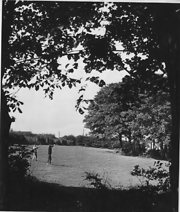 Donated by Ann Lacey
Donated by Ann LaceyPart of the Hartlepool Museum Service collection
Undated but on the reverse it says ' school holidays almost over and boys are having a last game of archery in the Burn Valley'.
More detail » Snow in Burn Valley
Snow in Burn Valley
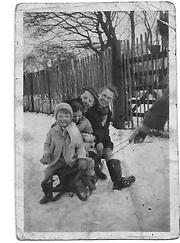 Donated by Frances Wilson
Donated by Frances WilsonDated 1956
A snowy scene in Burn Valley, 1956.
More detail » Snowy Scene
Snowy Scene
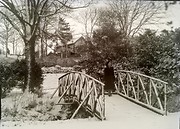 Created by NDM
Donated by Hartlepool Museum Service
Created by NDM
Donated by Hartlepool Museum ServiceThere is still a bridge, although it is a newer one, at this spot. Today it is next to a wild, pond dipping area.
The building in the background is Rosebank which housed part of Rosebank High School. It is no longer there and a small group of houses are on the site.
The photo will be 1953 or 1954.
More detail » Snowy Scene in Burn Valley
Snowy Scene in Burn Valley
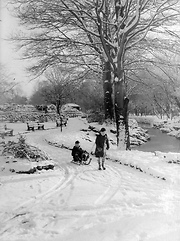 Created by NDM
Donated by Hartlepool Museum Service
Created by NDM
Donated by Hartlepool Museum ServiceThe Burn Valley has always been popular in winter and here two boys, in short trousers, are enjoying the snow. The area to the left is where there is now a slide and the beck is to the right. This was taken in the early 1950s.
More detail » Stockton Road
Stockton Road
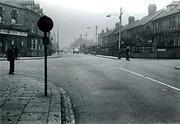 Donated by Hartlepool Library Service
Donated by Hartlepool Library ServiceJunction of Stockton Road and York Road, Hartlepool, Burn Valley Gardens on the right.
More detail » Strolling in the park
Strolling in the park
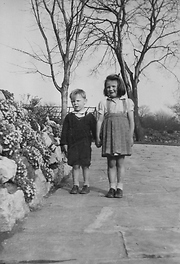 Donated by Mr. Brian Ward
Donated by Mr. Brian WardBrian and Margaret Ward in the Burn Valley Gardens.
More detail » The Peter Pan statue in Burn Valley Gardens
The Peter Pan statue in Burn Valley Gardens
 Donated by Mrs. Maureen Ledington
Donated by Mrs. Maureen LedingtonA rare image of the Peter Pan statue taken sometime after it had been formally presented by the Guides and Brownies to celebrate the coronation of King George VI in 1937.
Having been replaced from donations and fundraising by guides and brownies in 1961 after it was vandalised, it was again vandalised in 1962.
More detail » View of Elwick Road circa 1954
View of Elwick Road circa 1954
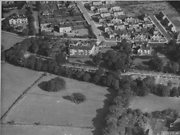 Created by Aerofilms
Part of the Hartlepool Museum Service collection
Created by Aerofilms
Part of the Hartlepool Museum Service collectionDated 1954
The two large houses in the foreground looking over the Burn Valley Gardens, are Ambleside on the left and Rosebank on the right and these formed Rosebank School. The large white house on the top left on the Elwick Road/ Queensberry Ave corner is Hartdale which is still there today although it is divided into two homes. The large white house top centre was Broomhill home of the Forslind family. This house was demolished in 1970 and a number of bungalows occupy the site.
Newlands Ave is the road in the centre running vertically and Westlands, Northlands, Eastlands, Southlands Avenues can be seen having been built after WW2. Claremont Drive can be seen but is very incomplete and only the first few houses built for RAF (Army ?) personnel are apparent on the top right.
More detail »




